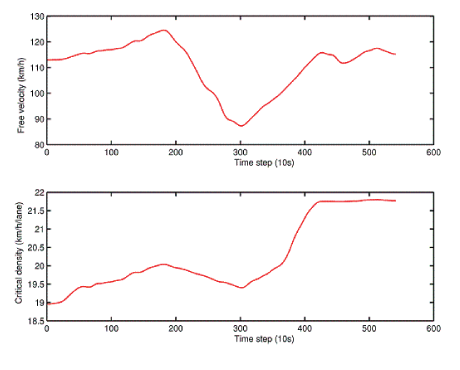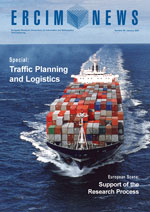by Tamás Luspay, István Varga and Balázs Kulcsár
The design of modern optimal control strategies is one of the research activities of the Systems and Control Laboratory, SZTAKI, through the project 'Advanced Vehicles and Vehicle-Control Knowledge Centre'. We have applied modern system and control theory to a variety of fields, and this has recently led to new results in urban traffic control and freeway traffic applications
The basis of freeway control is a mathematical description of traffic flow that incorporates as many traffic characteristics as possible. We first summarized and analysed existing models, and found the second-order macroscopic traffic model to be the most accurate and appropriate for our aims. This model is based on the analogy between fluid mechanics and traffic behaviour, and this can be extended to include special traffic phenomena such as congestion. The model works with the traffic variables of density, flow and space mean speed. Although the model equations are precise, there are several unknown parameters that must be properly tuned in order to achieve the best performance.
Model Calibration
We modelled a 4.5 kilometre stretch of a Hungarian freeway with on-ramps and off-ramps and with different geometric properties (ie slope, rising, curves). This allowed us to study the effects of these road properties on the traffic flow. These are reflected in the values of the above mentioned unknown parameters. We studied the determination of the parameters, and worked out three different methods.
The first method is a classical traffic-engineering approach: based on the measurement data, calculate the parameters using the theory of nonlinear kinematic waves. The second is a classical system-engineering approach: based on the measurement data, identify the parameters with nonlinear optimisation theory. Both these methods gave similar results.
During optimisation we also analysed the scope of the model equations. The state limitation of the model was found to be half a kilometre, so our observed section of freeway can be divided into segments. These can be described with equations and then connected to each other according to the boundary relations indicated in the equations.
Freeway Traffic Estimator
By determining the parameters, we get a compact nonlinear state-space representation of the stretch of freeway. Based on this, algorithms can be developed to improve the capacity of highways. Our main idea was the following: the information provided by traffic flow detectors on freeways is limited to their installation locations. In order to acquire information about conditions between detectors, a freeway traffic estimator is necessary. Since the model equations are highly nonlinear, we chose a well-known nonlinear estimation technique to do this: the Extended Kalman Filter. Our freeway traffic estimator estimates the states - the traffic variables - of each freeway segment, by modelling the noise actuating on the process and disturbing the measurements. The estimator uses real measurement data collected by inductive loop detectors located at the beginning and end of the examined section, and the simulation is evaluated by comparing the estimated variables with real data gathered from a 'control' loop detector located in the middle of the 4,5 km long section. The results show good state estimation under both normal and changing conditions.
The main drawback of these parameter determination methods is that in real traffic, the parameters (and the noise variance) can vary in time and space. Consequently, using constant parameter values is an oversimplification. To overcome this we extended our estimator to give parallel estimation of parameter values and to allow the parameters to vary. This also gives significantly more information about traffic conditions; for example, sharp changes indicate an incident (see figure).

Several applications can now be developed based on this dynamic model and with the usage of the traffic estimator. In our research we designed a new Automatic Incident Detection algorithm to perceive accidents that have occurred on freeways. Our method works with the estimated variables and checks changes in the speed-curve of the section. In this way we can identify accidents between detector stations with an accuracy of 500 metres. The algorithm was successfully tested with real data. We also drafted the principles of freeway control strategies and simulated them with our model.
Our further research will focus on:
- correction of our dynamic model
- the application of LPV (Linear Parameter Varying) technique to model traffic flow
- MHE (Moving Horizon Estimation) estimation of traffic variables
- adaptive filtering techniques to allow changing noise variance
- developing coordinated freeway control including ramp metering and the usage of variable speed limits
- testing the developed systems in real time.
Traffic control design is one of the main tasks of the long-term project 'Advanced Vehicles and Vehicle-Control Knowledge Centre', managed by SZTAKI, Systems and Control Laboratory in cooperation with the Department of Control and Transport Automation at the Budapest University of Technology and Economics.
Links:
http://www.sztaki.hu/scl
http://www.ejjt.bme.hu
Please contact:
Tamás Luspay and István Varga SZTAKI, Hungary
Tel: +36 1 279 7266; +36 1 279 6227
E-mail: tluspay![]() sztaki.hu; ivarga
sztaki.hu; ivarga![]() sztaki.hu
sztaki.hu









